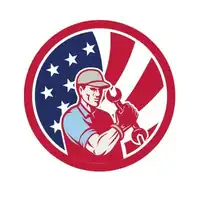Do you know how to get your truck unstuck from deep mud? this is one of the questions our readers ask a lot. Well, we´ve got you covered.
If you are in unfamiliar terrain or just caught by surprise, you may find your truck bogged down in the mud.
The most important thing to do is not panic and make the situation worse. If your truck is stuck in deep mud, you have several options.
So, how to get your truck unstuck from deep mud? To get a truck unstuck from deep mud, first assess the situation, then clear all the debris around your tires. You should attempt to provide traction underneath your drive wheels and proceed at a low gear. Consider a snatch recovery or a winch to pull you out if you are still stuck.
Often off-roaders can make their situation worse by not taking the time to assess the situation and make a measured plan.
Most times, you can get your truck out yourself, or worst-case scenario, you may have to elicit someone’s help. Here are some ways to get a truck unstuck from deep mud explained.
Table of Contents
Try to Increase Your Traction
There are several ways to try and increase your tire traction to get you out of deep muddy terrain.
If your wheels are spinning without purchase, you should immediately leave the vehicle and ask your passengers to leave the truck to alleviate excess weight.
Assess the situation calmly and ascertain how deep the mud is and which wheels are stuck. You should also ensure you know the distance between you and solid ground.
Hopefully, if you are an experienced off-roader, you will have a traction kit as an emergency provision in your vehicle; if not, you may have to improvise.
Read also: How to Get Traction in Mud (Car Stuck In Mud Help)
How to Increase Tire Traction
- Clear the mud and debris from your wheels as much as possible, using a shovel or what you can find.
- Check the immediate area of your wheels and your intended route for obstacles such as rocks or tree limbs.
- Use a jack such as a hi-jack to lift your wheels and use portable recovery tracks such as Maxtrax or what you have at hand to provide traction at the base of your drive wheels. Some forums suggest that your car floor mats will do in a pinch.
- Engage a low gear and try and maintain momentum while accelerating evenly and consistently. Sudden acceleration will dislodge your traction material.
- If you fail to move, use a rocking motion of acceleration and reverse to try and rock your wheels out of their stuck position.
You won´t believe this trick to get your truck out of the mud >> Check out the video below:
Reduce Your Tire Pressure
Off-road forums always suggest that drivers decrease their tire pressure when stuck in conditions such as mud or snow.
Letting down your tires’ air increases the contact area between your tires and the ground and lengthens the tread. Most off-roaders suggest a decrease of 15-20psi in muddy conditions to aid in traction.
One caveat is that you should not attempt this action unless you have a compressor to air your tires back up to the proper psi.
Once you are free, the lowered tire pressure may be dangerous as the increased surface contact of the tire on the road may lead to a blowout.
Just as crucial as airing down is having the tools at hand to air back up again. Driving at a speed below recommended pressure may damage the tire and cause a blowout.
You should ensure your tire s restored to proper psi before venturing back on the roads.
Read also: Can I Use Off-Road Tires on the Highway (Mud, All-Terrain)
Winch Recovery
Winch recovery may be your only alternative if you are off-roading off the beaten track and you are not likely to find rescue.
One of the essential tools in an off-roaders arsenal is a properly working winch. Of course, a winch on its own is useless, so your winch recovery kit should contain at least:
- A tree protector strap
- At least two rated shackles
- A snatch block
- 2 winch line damper
- Gloves
- A winch line extension (Optional.).
How to Safely Winch Yourself out of Deep Mud
1 Assess your situation. It is essential to know what distance you are from solid ground and finding a suitable winch point.
If you use a tree as your winch point, make sure it is a live tree as dead trees tend to pull out at the roots.
2. Make sure your winch path is a straight as possible and free from obstacles. Avoid side loading your winch as this may lead to mechanical failure.
3. Check that your wire rope is in good order and neatly wound around the drum before free spooling it to conserve battery life.
4. Ensure your connection points are rated and secure, with a few metal connections as possible.
5. Place a damper in the center of your winch line to absorb recoil should anything happen to your connections or wire rope.
The safest option is to use two dampers, one at the center of the line and one closest to any metal components.
6. Clear a safe area at least the distance of your rope, and re-check your connection points. Ensure you have a clear plan of action regarding steering and a safe place to stop.
7. Take your winch off free spool, take up the slackline, put your vehicle in low-range first gear, and proceed to winch.
8. Slowly turning your wheels from side to side may help break the mud suction. Try and match your speed to the speed of the winch and take care not to overrun the line.
If your winching time extends too long, take frequent breaks to prevent the winch motor from overheating.
Read also: How to Drive in Mud with 2WD (Get Traction)
Snatch Recovery
Suppose all four of your wheels are spinning uselessly in the mud, and you have exhausted every avenue trying to get your truck moving.
In that case, you may consider allowing another vehicle to help you regain traction through a snatch recovery.
A snatch strap is made of elasticated nylon webbing with a loop ion on either end to attach between two vehicles.
These loop points must connect only to rated recovery points and rated shackles because failure to consider these weight capacities could result in severe injury or even death.
Unlike taught ropes, the snatch strap uses elasticated stretching to absorb and use kinetic energy to literally snatch a vehicle from where it is stuck.
Ensure that you choose a strap with a capacity that takes into account the increased force exerted by the area in which the vehicle is trapped. Most commonly, the straps have an 8 000kg rating but can go higher.
How to perform A Safe Snatch recovery From the Mud
- Clear all obstacles from the stuck vehicle and ensure that the path out of the mud is clear. Typically is easier to recover a vehicle in the direction that it came from.
- Ensure that you use rated straps and shackles with clear weight ratings for the load.
- First, attach the snatch strap to the stuck vehicle and placing your rated shackle through the end loop of the strap and then through the appropriate recovery point of the vehicle.
- The shackle pin should go through the recovery point and be tightened until completely locked and loosened by a half turn to prevent seizing.
- Layout the snatch strap in a loose S shape about one meter in length back up the rescue vehicle and repeat the attachment to the rescue vehicle.
- Make sure there are no twists or kinks in the strap, which will weaken the strap’s kinetic pull.
- Place a rope damper in the center of the snatch strap for extra safety.
- Make sure everyone except the drivers are at a safe distance should anything snap or come loose. Ensure the drivers are in communication at this point and wearing their seatbelts (no passengers allowed.
- The rescue vehicle should set off in 2nd gear ad the stuck vehicle should assist in letting its wheels also turn in the low ranges. They should accelerate gently to see if the truck moves.
- You may have to remove more debris around the path and wheels and reattempt the process if it doesn’t.
Conclusion
If you travel off-road or find yourself in an area prone to seasonal mud, the best thing to do is be prepared.
Traction pads, winches, and recovery kits are essential in hazardous terrain, especially when exploring off-road.
A calm head and a concrete plan are the two most important tools to free your truck from a sticky situation.
Here are some of my favorite tools & equipment´s
Thank you for reading this article. I hope it helps you find the most recent and accurate technical and repair information for your car. Here are some tools that I use as an automotive technician and hope you´ll also find helpful.
There are affiliate links, so if you do decide to use any of them, I´ll earn a small commission. But in all honesty, these are the exact tools that I use and recommend to everyone, even my own family. (NO CRAP)
To see all my of most up-to-date recommendations, check out this resource that I made for you!
References
https://www.landrover.com/ownership/4×4-off-road-driving-tips/off-road/mud-driving.html
Recent Posts
Off-roading is a great adventure but not always of the positive kind. Sometimes you may find yourself underestimating the depth of a mudded area, and before you know it, you are spinning out and...
Have you ever asked yourself how to drive in mud with 2WD? Well, you are at the perfect place to find the answer to such a question. Although 4WD vehicles are the ultimate off-road option, it does...


